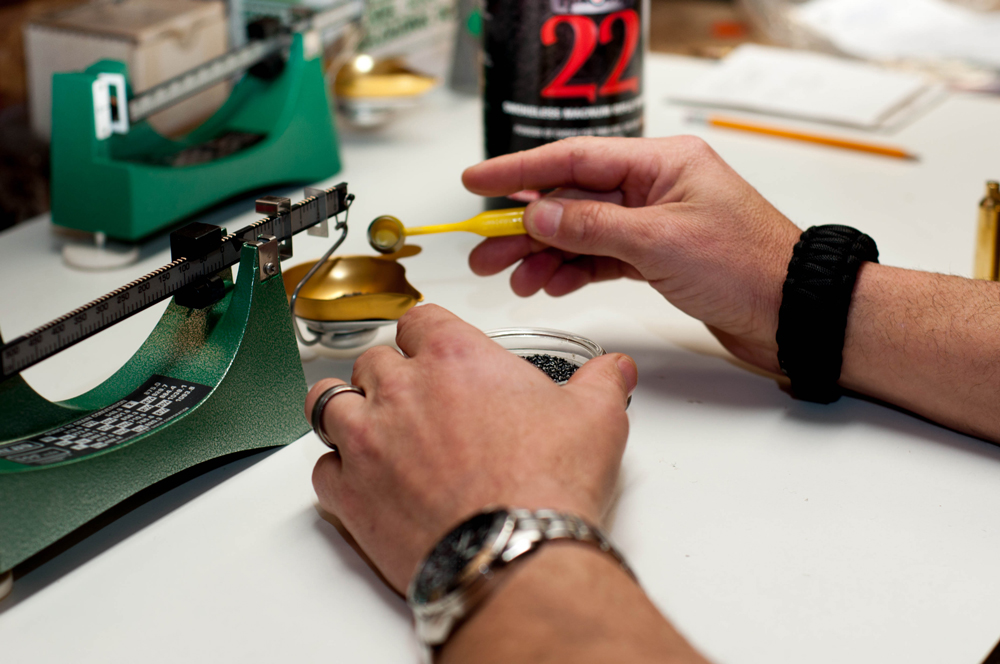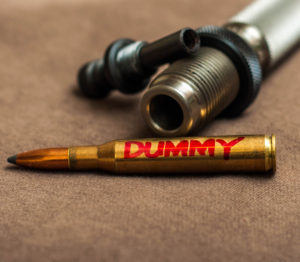

When it comes to reloading techniques, there are some tricks and tips master ballistician Phil Massaro has picked up that make it safer and more efficient.
Everyone has their own style in this world, different strokes for different folks. However, some things that people attribute to style can be downright dangerous. Let’s talk about some simple and safe reloading techniques, which might save you wounded pride, or worse, body.
Priming
When it comes to priming your cartridges, I used to just dump a bunch of primers into the tray, and have at it. I’ve ended up trying to prime a case that is already primed (ruining the existing primer), and I’ve ended up with a case that has powder trickling out of the unprimed pocket.
Nowadays, I dispense the exact amount of primers I need for the cases I have in the case block. If I end up with more cases than I have primers for, I know to get on my hands and knees and check the floor for a primer that has dropped so it doesn’t end up in the vacuum cleaner or elsewhere.
Charging
I have friends, who are safe people in general, that will set 40 or 50 primed cases into a case block, and charge each case before seating the bullets into them. It makes for a good system, but it leaves open the opportunity for a double charge, or no charge at all.
I have done the ‘no-charge-at-all’ thing; it’s a mistake that almost everyone will make if they load enough cartridges. I’m not proud of it, and I’ve taken every precaution to see it never happens again. Thank goodness I’ve never had to deal with a double-charge, as the results of those can be deadly, or at least maiming.
I have modified the procedure a bit, to make things a bit safer. I still place the primed cases into the blocks, but I charge them with powder one at a time, and then immediately install the bullet and seat it. This alleviates a couple different problems.
There is no risk of a double charge, because I visually identify that there is no powder in the case before I charge it, and there is no risk of ‘no-charge-at-all’, because I can verify that there is powder in the case before seating the bullet. This works out well for any single stage press, whether for pistol or rifle.

Seating
If you load more than one bullet for any particular cartridge that you load for, the seating depth will more than likely change. The time spent readjusting a seating plug can become a pain, so I make a dummy round for each bullet that I load for, set to the exact seating depth required, and I keep it in the die box, labeled in permanent marker, with the bullet weight and name.
This way, when it comes time to switch bullets, you may back off the seating plug, raise the dummy round into the die, and screw the plug down until you feel it kiss the ogive of the bullet. That will get you very close, but one minor adjustment and a quick check with the micrometer and you’ll be in business much quicker.
Basic tips, I know, but sometimes it’s the little things in life that make things go smoothly.

Next Step: Get your FREE Printable Target Pack
Enhance your shooting precision with our 62 MOA Targets, perfect for rifles and handguns. Crafted in collaboration with Storm Tactical for accuracy and versatility.
Subscribe to the Gun Digest email newsletter and get your downloadable target pack sent straight to your inbox. Stay updated with the latest firearms info in the industry.

![Best Concealed Carry Guns In 2025 [Field Tested] Wilson Combat EDC X9S 1](https://gundigest.com/wp-content/uploads/Wilson-Combat-EDC-X9S-1-324x160.jpg)


![Best 9mm Carbine: Affordable PCCs [Tested] Ruger Carbine Shooting](https://gundigest.com/wp-content/uploads/Ruger-Carbine-Shooting-100x70.jpg)
![Best AR-15: Top Options Available Today [Field Tested] Harrington and Richardson PSA XM177E2 feature](https://gundigest.com/wp-content/uploads/Harrington-and-Richardson-PSA-XM177E2-feature-100x70.jpg)

I have found that errors will occur no matter what process you use. As a last safety check after all my reloading is done I weigh each cartridge before storing them for later use. This will find any empty charges and double charges.
Good techniques critiqued. The “Dummy Round” in particular.
For other than the same bullet (not critiqued), the dummy round may be replaced by the case cut longitudinally by hacksaw, where the new bullet may be loosely inserted. Then the die may be turned down until it kisses the ogive, and below, checking frequently for the anticipated engagement of bullet to case.
I really like the concept of making a “Dummy Load”. My only problem is that I probably have at least fifty different rounds (if not more) that I currently work with for long guns. Really do have to give this a try though. Thanks. I’m one of those who loads hand gun cases in the block. I have my own routine to cover my butt. I ALWAYS take my little CSI flashlight and check every casing before I start seating bullets. Different strokes 🙂
Some very good points here. I also seat bullets immediately after charging. I use a strip LED and a powder cop on my rotary press. Charging, visual check powder cop, bullet seat, crimp. one at a time No speed records here but also no missed or double charges. Don’t intend to try to feed an AR.The tray holds primed empty brass and then completed cartridges.
My process is similar; but: I charge all 50 cases in the block and then visually check to ensure that the powder level is the same in each case. Then, I press in the bullets. With my press, that keeps me from having to change dies twice for each cartridge loaded.
It seems to me that two of your biggest problems have something to do with loading blocks, which is why I NEVER use them. I believe that loading blocks have caused more problems then they have ever solved. Once a case is powdered, I immediately set the bullet and seat it. It makes n o difference whether it is a rifle or pistol case. Seating the bullet right after charging it with powder assures that no powder will be spilt, and that a case will not go by uncharged.
My process has always involved two loading blocks – one labelled EMPTY, one labelled CHARGED. I start by putting my empties in the EMPTY block and move them to the CHARGE block. After I’m done, visually inspect them, sometimes with a flashlight, and then move to seating. I don’t do more than 50 at a time. If I have multiple calibers to load, finish one and move to the next. It’s quite a simple and quick process.
Loading blocks can be a source for error. Only use blocks to arrange empty primed cases ready to load. I often load different powders, charges, and bullets on one run. Found it best to charge empty case ,then immediately seat bullet . Finished cartridge is visually checked and every fifth is checked for CBTO (cartridge base to ogive length) .If all is still good ,cartridge is placed in marked cartridge box for storage and use. A load data sheet accompanies each loading or build and is matched up with firing data such as accuracy and velocity ,and other variables for evaluation. Empty primed cased and bullets are pre-counted and paired prior to loading. Primer seating depth was pre-checked at time of seating.Only the one powder in use is ever out. Errors are rare on data is accurate. All rifle and pistol chambers, throat and leade were checked and pre-measured using cerrosafe casting ,which also included head space measurement.